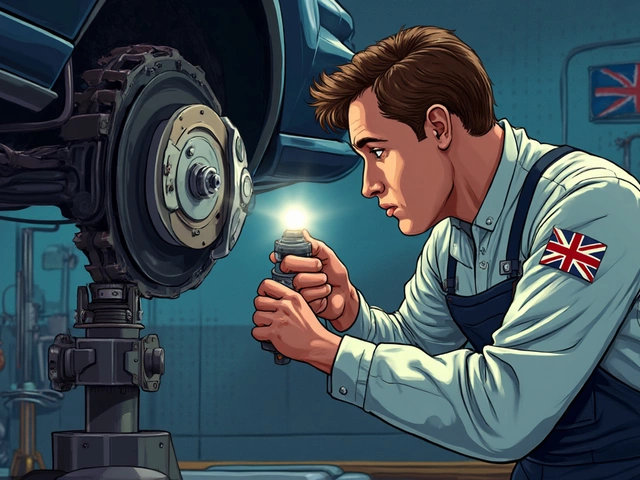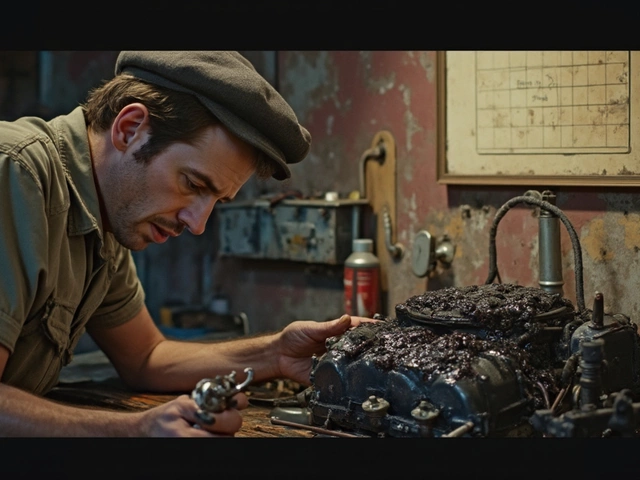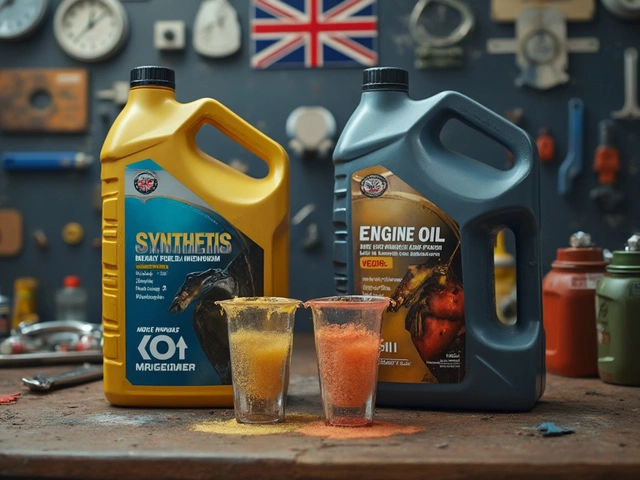Driving should be a smooth and seamless experience. But what happens when you start hearing unexpected noises from your vehicle? These unsettling sounds can often indicate a problem with the car's suspension system. Whether it's a persistent rattle, an eerie creak, or a harsh clunk, the noises you hear can provide valuable insights into what's going on beneath your car’s body.
Each type of sound has its own character, and understanding the nuances of these noises can be incredibly helpful. They can point to specific issues like worn-out shock absorbers, broken springs, or unlubricated joints, among others. Knowing what to listen for can help you identify the problem early, allowing for timely repairs and avoiding potentially costly damages.
In this article, you'll learn the different sounds associated with faulty suspension, what they might mean, and steps you can take to address these issues. We'll provide you with practical tips and guidance to ensure your vehicle remains safe and reliable on the road.
- Common Noises from Bad Suspension
- What Causes These Noises
- How to Diagnose the Problem
- The Importance of Timely Repairs
- Preventive Measures for Suspension Maintenance
Common Noises from Bad Suspension
Driving along a winding road only to be greeted by an unexpected noise can throw even the calmest of drivers for a loop. A bad suspension doesn't just make your ride uncomfortable; it resonates with a symphony of peculiar noises, each indicating a specific underlying issue. Perhaps the most common of these is a persistent clunking sound, often heard when your vehicle navigates bumps or surfaces that aren't perfectly level. These disconcerting clunks are typically indicative of a loose or broken suspension part, such as a fault in the sway bar links or control arm bushings. So the next time you drive and hear that dreaded clunk, it's worth paying attention before it leads to more extensive damage.
Another noise you'll want to be familiar with is the squeaking sound, especially prevalent when turning the steering wheel or while driving at slower speeds. This high-pitched noise often raises red flags about dry or damaged suspension joints, crying out for lubrication or replacement. Shock absorbers that have seen better days can also contribute to such annoying squeaks, making every drive an ordeal. Curious fact: a study by the Automotive Research Organization showed that more than 60% of cars with squeaking suspensions needed strut or joint maintenance! Such figures highlight the importance of interpreting these audial cues correctly.
Then there's the infamous rattling noise, a sound no car owner ever welcomes. While some rattles can be benign, perhaps emerging from loose items in the vehicle, rattles originating from below may point to worn-out ball joints or deteriorating suspension mounts. The movement of these components can cause constant vibrations, leading to rattling that gets worse with time. According to a veteran mechanic from AutoTech Today, "A rattle under your car is never just noise; it's the sound of a problem in hiding." Rattles often mark early symptoms of wear that might escalate if left unchecked.
Let's not forget about the knocking noise, a distinct sound that can occur during acceleration or deceleration. This could be caused by issues with the drive shaft or loose suspension struts. It often strikes fear into the hearts of drivers but serves as a crucial prompt for checking the car's components. The repetitive nature of the knock might lead you to believe it plays like a tune but rest assured, it’s more ominous than that. Since most suspension issues start with such hints, recognizing them is vital.
In essence, each car noise serves as an audible symptom of suspension problems, and tuning into these noises can secure your vehicle's health. If you experience any of these, it's essential to take action promptly. Rolling over bumps shouldn't sound like playing a percussion instrument; it should be smooth and quiet. Understanding what your car is telling you allows for timely interventions that keep both your driving experience and peace of mind intact.
What Causes These Noises
When you're out on the road, the suspension system of your vehicle plays a crucial role in ensuring a comfortable ride. However, when certain components start to fail, they often communicate distress through a variety of unsettling sounds. Comprehending the causes of these noises is an important step in diagnosing the problem. The myriad of clunks, rattles, and creaks you may hear typically originate from wear and tear, poor maintenance, or unexpected impacts your vehicle has undergone.
The first noise that often raises concern is the ever-common clunking sound. This unmistakable noise usually signals components like suspension arms, shock absorbers, or ball joints that have perhaps lived past their prime. As these parts experience strain and load over time, degradation is inevitable. Clunking can often suggest that a part is loose or not securely fastened, allowing metal to collide with metal excessively.
“Your car's suspension is like a silent guardian - it only becomes vocal when something is awry.” - James Whitham, Automotive ExpertBut that's not the only sound you might encounter. Squeaking noises often develop when bushings, which act as cushions between different suspension parts, become worn. Without adequate lubrication, the friction between surfaces creates that high-pitched creaking. On the other hand, a rattling sound may be heard if parts like your link-pins or stabilizer bar mounts have come loose or broken free, creating gaps and letting components shake more than they should.
The cause of suspension issues can also often be traced back to driving habits and road conditions. Driving over potholes or rough terrain at high speeds can lead to early deterioration of suspension parts. Such impacts can distort or bend components, forcing them to work inefficiently. If you're an avid off-roader, your car's suspension endures a workout like no other, potentially leading to early faults. Additionally, rust and corrosion, especially in regions with harsh winters and road salt usage, can harm the longevity of your suspension system. It isn’t uncommon for certain components to deteriorate faster without proper protection and care.
Even weather can play a pivotal role, affecting how moisture interacts with metal parts. Moisture intrusion into stressful environments like car suspension bearings or joints can lead to rust build-up. Winter salts or dirt can act as catalysts in these contexts. Plus, failing to replace parts at the requisite intervals according to your vehicle’s maintenance schedule heightens the risk of hearing such auditory warning signs. As drivers, understanding the connection between our actions and the responses of our vehicle creates better road safety and maintenance practices.
Due to these multiple facets influencing the integrity of your suspension, it’s advised not to ignore any strange noises. Ignoring them may lead to significant problems down the line, both mechanically and financially. Relying on periodic inspections can also help keep these niggling noises at bay. By addressing potential problems before they fully manifest, you're saving the hassle -- and safety -- of driving a potentially compromised vehicle. That approach certainly brings peace of mind not only to you but also those you share the road with.

How to Diagnose the Problem
Diagnosing issues in your car's suspension is crucial in maintaining a smooth and safe ride. At the heart of this process is distinguishing the distinct car suspension noises that might signal a problem. Armed with this knowledge, you're better positioned to prevent more significant issues that might lead to costly repairs. One common approach is to put your vehicle through a small series of tests designed to pinpoint what's not right under the hood. Listen carefully as you take your car for a drive along varied road surfaces, noting distinct sounds such as clunks, rattles, or squeaks. Each noise hints at particular problems, thereby simplifying the diagnosis process.
On your drive, try replicating the noise by gently rocking the car or driving over bumps. Often, clunking noises, particularly when turning, might indicate worn ball joints or control arms. Squeaks could point to rubber bushings in need of lubrication. Another step involves visually inspecting tires. Uneven wear patterns, cupping, or bald spots usually tell tales of suspension problems. Don’t hesitate to detour from the beaten path and engage in tactile testing. Give each wheel a firm shake, both vertically and horizontally, to feel for excess give, as this could suggest loose components such as tie rods or bearings.
Let's not be shy about involving technology either. Modern diagnostic tools, available at most auto shops, can read the car’s error codes, some of which may be associated with suspension faults. A fail-safe avenue for DIY-ers includes using a mechanic's stethoscope, which can localize hard-to-distinguish sounds emanating from your vehicle’s undercarriage. For the more tech-savvy, smartphone apps are emerging as valuable diagnostic aids. By placing your phone at strategic positions on the car frame, these apps can assess vibration frequencies, offering additional clues.
Testing the suspension involves more than auditory examination; it’s a full-body inspection of sorts. Park your car on level ground and push down on each corner, observing how many bounces the car makes. More than two bounces often suggest worn shocks or struts, components pivotal in controlling your car’s stability. Don’t forget to pay attention to the steering response. Increased vibration or difficulty turning is a red flag that shouldn’t be ignored. Vehicle maintenance is a comprehensive practice that includes ensuring your suspension parts are up to the mark.
Occasionally, you’ll need to channel your inner detective, delving deeper into aspects such as the sway bar, linkages, and springs. Creating a checklist based on diagnostics observed allows a systematic approach to isolating issues. As the legendary mechanic Jack E. Sabo once mentioned,
“Suspension is the lifeblood of vehicle stability. Ignore it, and anticipate a rocky ride.”His wisdom underscores the importance of not only identifying problems but doing so promptly and decisively.
For persistent problems or if you’re in doubt, consulting a specialized mechanic can be invaluable. Experts possess both the experience and high-tech equipment essential in performing a thorough inspection. Given the interconnected nature of suspension parts with other automotive systems, misleading diagnoses are far from rare. Hence, leveraging professional expertise ensures no stone is left unturned, reinforcing both your vehicle's health and your peace of mind.
The Importance of Timely Repairs
Imagine you're cruising down a scenic highway, when out of nowhere, your car starts making eerie noises. Most drivers would think to ignore it, but acting quickly can prevent bigger issues. The moment you notice odd sounds in your car suspension, it's crucial to pay attention and take action. Timely repairs can prevent small problems from escalating into major repairs, saving you both time and money in the long run.
When your suspension is compromised, it not only affects your car's performance but also your personal safety. A neglected suspension system might fail at a critical moment. This can lead to handling problems, and if severe, might contribute to loss of control on the road. It's like neglecting your own health; you don't want to wait until a minor issue becomes a serious condition. The same goes for your car's health. As an automotive expert once said, "A stitch in time saves nine," meaning that prompt attention can prevent more extensive repairs later on.
Timely intervention in suspension repairs ensures your vehicle maintains its structural integrity. A healthy suspension system provides stability and balance that is essential for efficient braking, steering, and acceleration. Ignoring those tell-tale noises can lead to uneven tire wear. This decreases fuel efficiency as your car has to work harder to maintain traction, leading to higher costs down the road.
Moreover, promptly addressing suspension problems stops the domino effect. Take, for example, faulty shock absorbers; they can cause excess wear across the entire suspension system, making your vehicle especially vulnerable over rough terrains or in bad weather conditions. Repairing these issues in a timely manner ensures a smooth ride while preventing incremental damage from adding up.
Repair costs are also a vital aspect to consider. Although it might seem expensive to address suspension noises immediately, putting repairs on hold often results in higher costs. Components such as struts, links, or bushings can degrade quickly if left unchecked. Fast-forward a few months, and you may find yourself needing a complete suspension overhaul rather than a simple part replacement.
Ensuring the integrity of your suspension system extends the lifespan of your vehicle, protecting your investment while keeping you safe on the road. So, next time you hear a pesky new sound from your car, remember the importance of dealing with car suspension issues promptly. Acting sooner rather than later can help keep your vehicle in top condition, guaranteeing many more enjoyable and safe journeys.

Preventive Measures for Suspension Maintenance
Keeping your car's suspension in top shape ensures a smooth ride and prevents potential suspension problems. Regular maintenance not only saves money in the long run but also keeps your vehicle safe and reliable. It's amazing how just a few simple habits can prolong the life of your suspension system. Start by making regular inspections part of your routine—look for visible signs of wear such as cracked or sagging springs and leaking shock absorbers. Even if these parts seem fine, it’s essential to tune into the sounds your car makes while driving, as they can hint at hidden issues.
Next, consider the quality of roads you frequent. Potholes and uneven terrain are notorious for taking a toll on suspension components. If you find yourself driving on rough roads often, be more vigilant with your maintenance schedule. A dramatic dip in ride quality or persistent noises should flag an immediate check-up. Remember, keeping tire pressure at the correct level can significantly lighten the load on the suspension, offering better protection against road irregularities. Balancing, rotating, and aligning your tires insure even wear, which is critical for optimal suspension function.
"Ignoring those little noises can lead to big expenses," says Michael Cahill, an automotive expert from AutoHub Magazine. "A stitch in time saves nine when it comes to vehicle maintenance."
Lubrication plays a pivotal role in suspension longevity. Periodically applying a good quality lubricant to moving parts, like joints and bearings, prevents grinding and premature wear. You can never underestimate the impact of fresh lubricants in ensuring smooth movement and extending life span. It's also wise to inspect bushings, which are small rubber bits that absorb friction between metal parts. Replace them as needed because they harden over time, losing their flexibility and effectiveness.
There is valuable wisdom in reading your vehicle's manual. It offers manufacturer-specific advice on maintaining the car's suspension system. Use it to understand service intervals—the recommended times at which your car’s various systems need attention. Sticking to these schedules is vital for ongoing health and efficiency. Surprisingly, many vital components rely on this booklet for best practices. Additionally, keep an eye out for official recalls or service bulletins related to your make and model, which might offer free or discounted repairs that could impact suspension.
For the curious, here's a glimpse at a sample car inspection schedule:
| Month | Inspection Focus |
|---|---|
| January | Tires and Pressure |
| April | Shock and Struts |
| July | Wheel Alignment |
| October | Lubrication check |
In the end, being proactive and attentive with preventive care carries numerous benefits. Your vehicle's resilience on the road increases significantly, translating to a safer, quieter, and more comfortable drive. Knowing how to maintain a harmonious relationship between car suspension and the road could dramatically reduce untimely visits to the mechanic and make those Sunday drives far more enjoyable.






